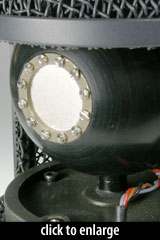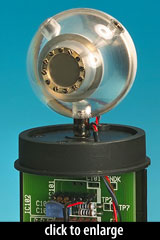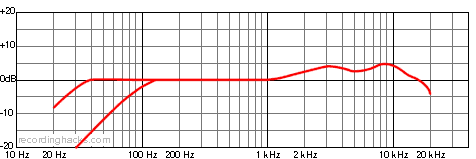 Neumann TLM 50
Neumann TLM 50
Omnidirectional Condenser Microphone
The TLM 50 was Neumann’s first reinterpretation of the vintage M 50 omni microphone, which was dropped from the product line in 1971.
In contrast to the M50’s tube-and-transformer design, the TLM 50 is a transformerless FET microphone. The new mic was intended to serve the same applications as the old — namely, distant ambient miking — but retained little of the original mic’s blueprint other than the spherical capsule.
 The idea of mounting a small-diameter omni capsule onto the face of a sphere originated at Northwest German Broadcast labs around 1948. The sphere has the effect of smoothing the capsule’s natural high-frequency peak, while making the capsule more directional at mid-to-high frequencies. The resulting mic is especially well-suited for ambient miking applications such as orchestral recording.
The idea of mounting a small-diameter omni capsule onto the face of a sphere originated at Northwest German Broadcast labs around 1948. The sphere has the effect of smoothing the capsule’s natural high-frequency peak, while making the capsule more directional at mid-to-high frequencies. The resulting mic is especially well-suited for ambient miking applications such as orchestral recording.
Stephan Peus, Neumann
By nature of its capsule design, has a particularly short transient response and exploits the acoustical pressure build-up and diffraction properties of a spherical surface:
- the smooth rise in the pressure build-up range for frequencies above 1000Hz
- a maximum pressure rise of 6dB in the 8kHz region
- the early and even increase in the directivity index with rising frequency, whereby … the frequency responses for side and rear sound are almost identical
The TLM 50 dropped the sloped, 3-layer-mesh grille of the M50, in favor of a cylindrical grill with an open mesh. Because the open grille is more susceptible to EMI/RFI (radio frequency interference, or hum), Neumann’s engineers came up with a new way to prevent interference within this microphone: they embedded a first stage of amplification within the sphere, allowing the output from the capsule assembly to run at a lower impedance. Neumann describes this as an “active capsule.”
The first TLM 50 used a 2.25-micron (sometimes reported as 2.5-micron) nickel membrane in a capsule called the K33 (or KK33, which probably refers to the capsule + sphere assembly). According to Anselm Roessler, creating thin nickel capsules was challenging; it involved coating a copper template with nickel, and then corroding the copper away. These chemical processes were expensive.
Around 2000, Neumann identified a source for titanium of sufficient quality, and redesigned the K33 capsule with a titanium housing and 5-micron titanium diaphragm. The TLM50 was changed to the new capsule; Neumann’s other spherical-capsule mic, the M 150 Tube, also used the new K33TI capsule.
 The sphere upon which the capsule is mounted measures 40mm in diameter, as on the M 50.
The sphere upon which the capsule is mounted measures 40mm in diameter, as on the M 50.
The TLM 50 has two switches on the rear of the microphone body:
- A 10dB pad that works by dropping the polarization voltage of the capsule, thereby reducing the mic’s output level by 10dB.
- A high-pass filter whose “LIN” (for linear) position has a -3dB point of 30Hz, and whose “100” position has a -3dB point of 100Hz.
The user’s guide warns that operating the pad switch might generate a short burst of noise. The same is true when the microphone is initially powered, or when phantom power is removed.
The mic ships in a wooden storage case with a 10m cable and an “auditorium hangar” (Neumann p/n MNV 87 mt). The mic and hangar are finished in flat black. The pictured shockmount is available separately.
The TLM 50 won a TEC Award from the MIX Foundation in 1991.
SoundOnSound, 1998
[T]he off-axis high-end loss was a little more pronounced than I had anticipated. This is a mic clearly designed to be used on-axis, where it produces a transparent, open sound that is also reassuringly solid at the low end.
The Neumann TLM 50 is also known as: TLM50.
The mic was released in 1990.
Specifications
| Frequency Response - OmnidirectionalClick Graph to Compare! |
|---|
 |
| Pickup Patterns | Pads & Filters |
|---|---|
|
Omnidirectional
(20 mV/Pa; 30 - 20,000 Hz) |
|
| Capsule Dimensions | Impedance | SPL/Noise |
|---|---|---|
| Diaphragm diameter: 12mm Diaphragm gauge: 5 microns |
50 Ohms (Low) | Max SPL: 136 dB Self-noise: 13.0 dB(A) |
| Weight | Length | Max Diameter | Interface(s) |
|---|---|---|---|
| 490g (17.28oz) | 145mm (5.71'') | 56mm (2.20'') |
|
| Power Specifications |
|---|
|
Did we get anything wrong on this page? Please let us know!


